Supply Chain Management and Logistics
VerifiedAdded on 2020/05/28
|18
|3940
|216
AI Summary
This assignment delves into the multifaceted realm of supply chain management and logistics. It requires a critical analysis of various aspects, including sustainable practices in urban logistics, the benefits of reverse logistics, warehouse location decisions in humanitarian relief efforts, and strategic partnerships within supply chains. The assignment emphasizes understanding the impact of technology on supply chain operations and the role of information systems in shaping digital strategies.
Contribute Materials
Your contribution can guide someone’s learning journey. Share your
documents today.
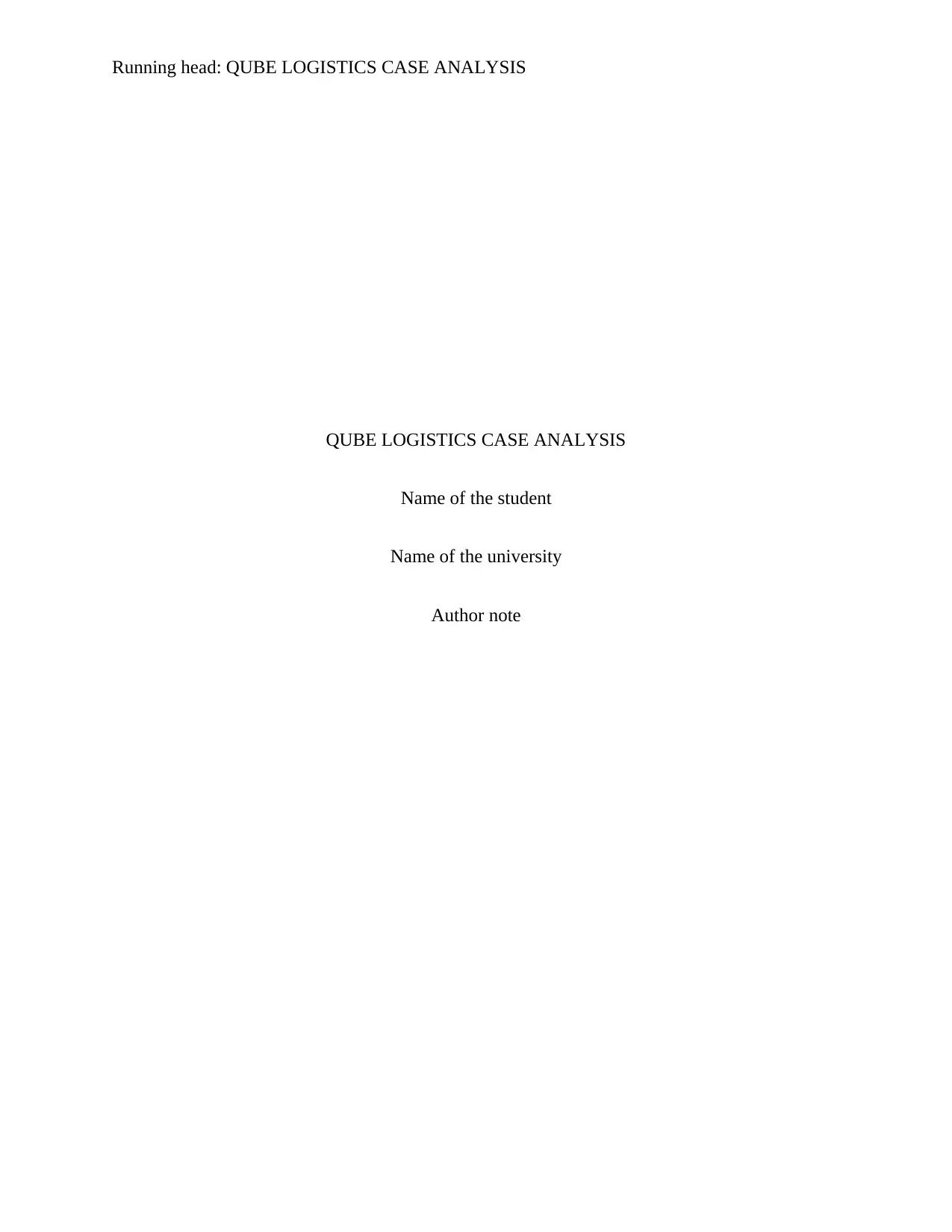
Running head: QUBE LOGISTICS CASE ANALYSIS
QUBE LOGISTICS CASE ANALYSIS
Name of the student
Name of the university
Author note
QUBE LOGISTICS CASE ANALYSIS
Name of the student
Name of the university
Author note
Secure Best Marks with AI Grader
Need help grading? Try our AI Grader for instant feedback on your assignments.
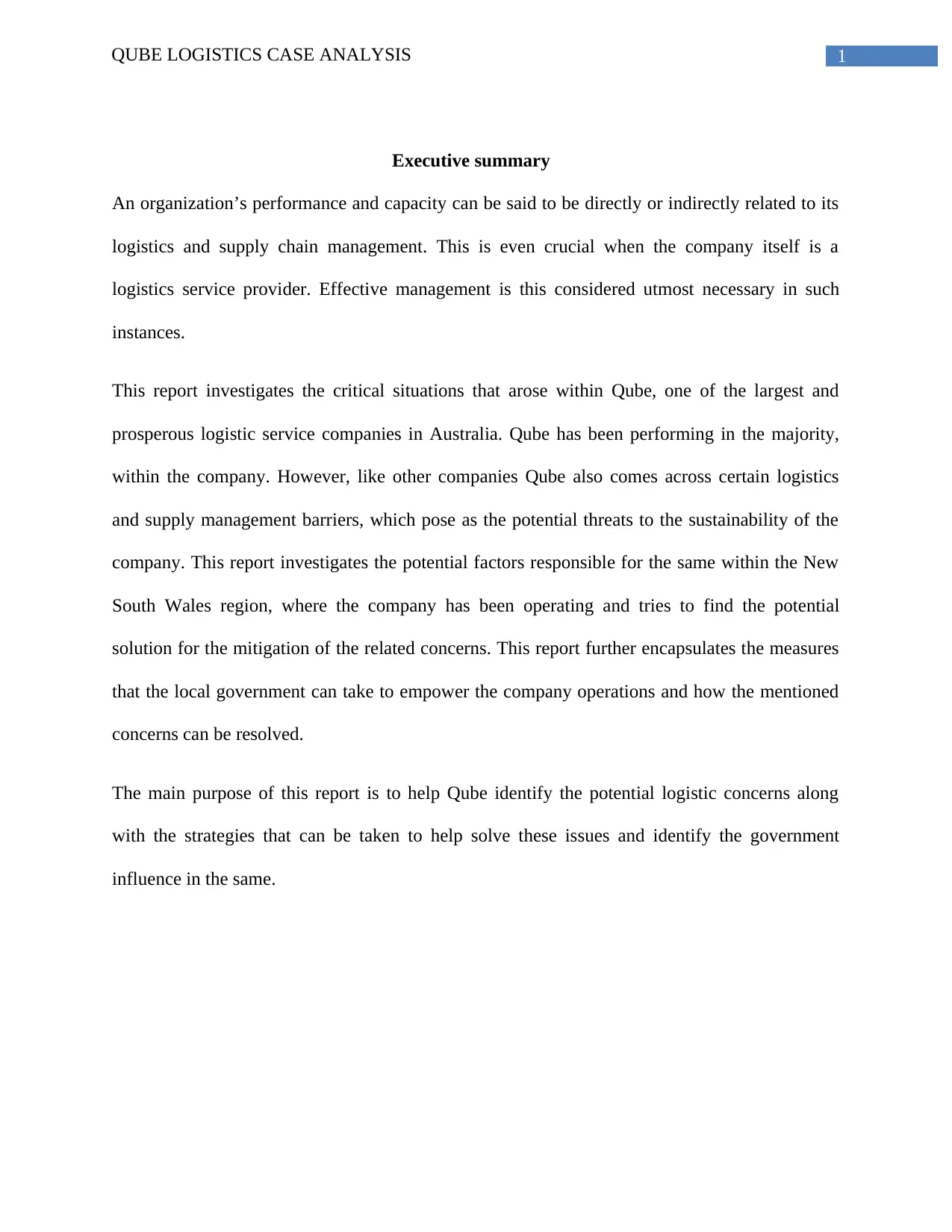
1QUBE LOGISTICS CASE ANALYSIS
Executive summary
An organization’s performance and capacity can be said to be directly or indirectly related to its
logistics and supply chain management. This is even crucial when the company itself is a
logistics service provider. Effective management is this considered utmost necessary in such
instances.
This report investigates the critical situations that arose within Qube, one of the largest and
prosperous logistic service companies in Australia. Qube has been performing in the majority,
within the company. However, like other companies Qube also comes across certain logistics
and supply management barriers, which pose as the potential threats to the sustainability of the
company. This report investigates the potential factors responsible for the same within the New
South Wales region, where the company has been operating and tries to find the potential
solution for the mitigation of the related concerns. This report further encapsulates the measures
that the local government can take to empower the company operations and how the mentioned
concerns can be resolved.
The main purpose of this report is to help Qube identify the potential logistic concerns along
with the strategies that can be taken to help solve these issues and identify the government
influence in the same.
Executive summary
An organization’s performance and capacity can be said to be directly or indirectly related to its
logistics and supply chain management. This is even crucial when the company itself is a
logistics service provider. Effective management is this considered utmost necessary in such
instances.
This report investigates the critical situations that arose within Qube, one of the largest and
prosperous logistic service companies in Australia. Qube has been performing in the majority,
within the company. However, like other companies Qube also comes across certain logistics
and supply management barriers, which pose as the potential threats to the sustainability of the
company. This report investigates the potential factors responsible for the same within the New
South Wales region, where the company has been operating and tries to find the potential
solution for the mitigation of the related concerns. This report further encapsulates the measures
that the local government can take to empower the company operations and how the mentioned
concerns can be resolved.
The main purpose of this report is to help Qube identify the potential logistic concerns along
with the strategies that can be taken to help solve these issues and identify the government
influence in the same.
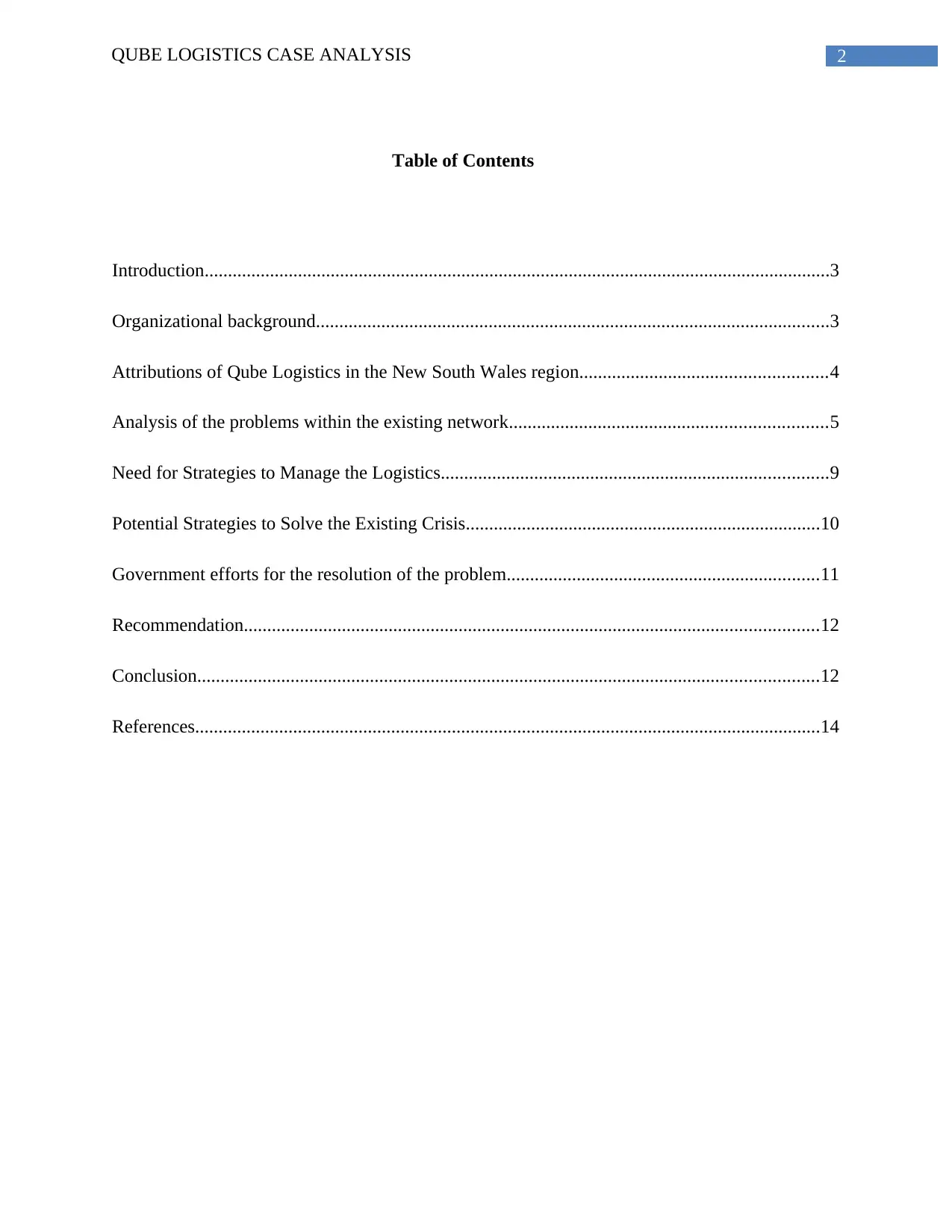
2QUBE LOGISTICS CASE ANALYSIS
Table of Contents
Introduction......................................................................................................................................3
Organizational background..............................................................................................................3
Attributions of Qube Logistics in the New South Wales region.....................................................4
Analysis of the problems within the existing network....................................................................5
Need for Strategies to Manage the Logistics...................................................................................9
Potential Strategies to Solve the Existing Crisis............................................................................10
Government efforts for the resolution of the problem...................................................................11
Recommendation...........................................................................................................................12
Conclusion.....................................................................................................................................12
References......................................................................................................................................14
Table of Contents
Introduction......................................................................................................................................3
Organizational background..............................................................................................................3
Attributions of Qube Logistics in the New South Wales region.....................................................4
Analysis of the problems within the existing network....................................................................5
Need for Strategies to Manage the Logistics...................................................................................9
Potential Strategies to Solve the Existing Crisis............................................................................10
Government efforts for the resolution of the problem...................................................................11
Recommendation...........................................................................................................................12
Conclusion.....................................................................................................................................12
References......................................................................................................................................14
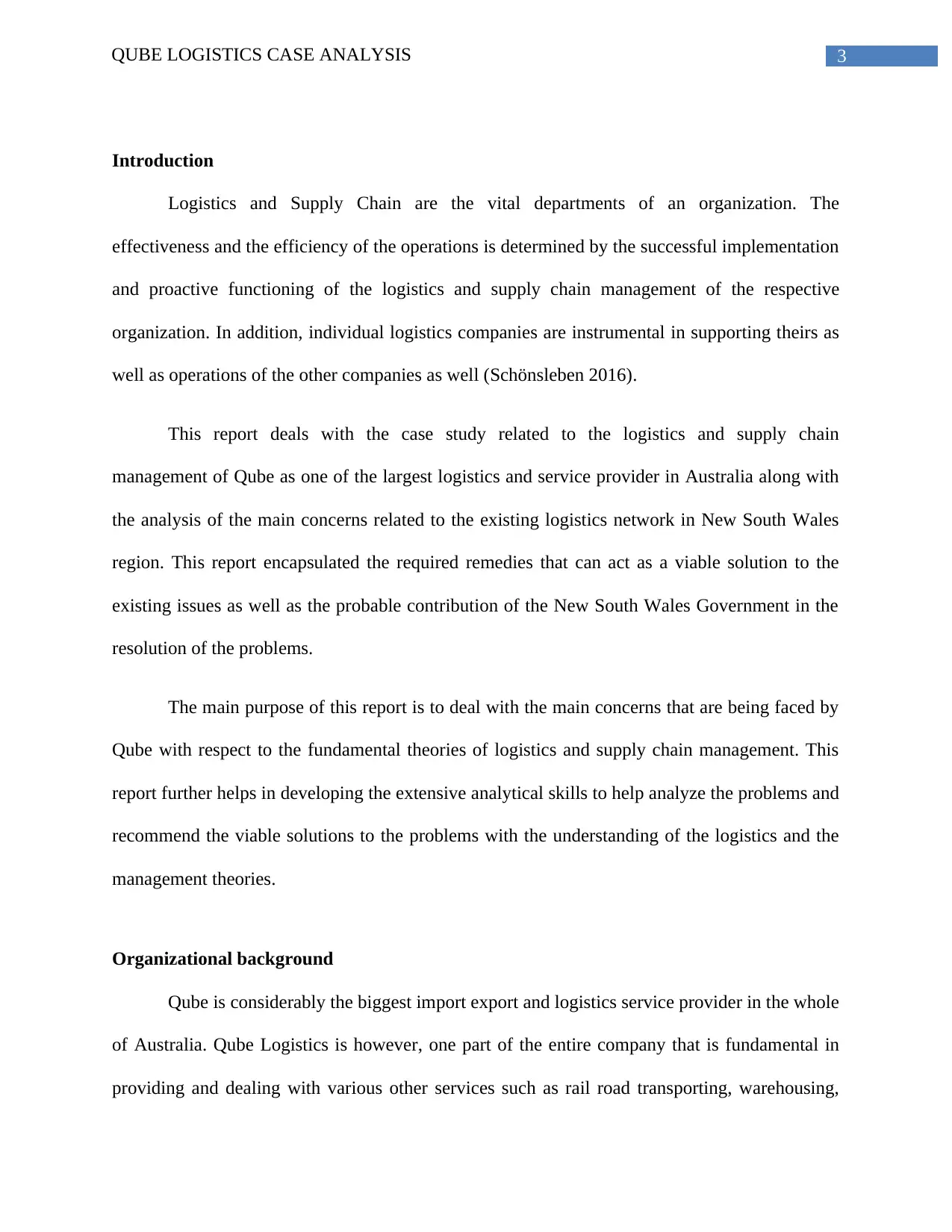
3QUBE LOGISTICS CASE ANALYSIS
Introduction
Logistics and Supply Chain are the vital departments of an organization. The
effectiveness and the efficiency of the operations is determined by the successful implementation
and proactive functioning of the logistics and supply chain management of the respective
organization. In addition, individual logistics companies are instrumental in supporting theirs as
well as operations of the other companies as well (Schönsleben 2016).
This report deals with the case study related to the logistics and supply chain
management of Qube as one of the largest logistics and service provider in Australia along with
the analysis of the main concerns related to the existing logistics network in New South Wales
region. This report encapsulated the required remedies that can act as a viable solution to the
existing issues as well as the probable contribution of the New South Wales Government in the
resolution of the problems.
The main purpose of this report is to deal with the main concerns that are being faced by
Qube with respect to the fundamental theories of logistics and supply chain management. This
report further helps in developing the extensive analytical skills to help analyze the problems and
recommend the viable solutions to the problems with the understanding of the logistics and the
management theories.
Organizational background
Qube is considerably the biggest import export and logistics service provider in the whole
of Australia. Qube Logistics is however, one part of the entire company that is fundamental in
providing and dealing with various other services such as rail road transporting, warehousing,
Introduction
Logistics and Supply Chain are the vital departments of an organization. The
effectiveness and the efficiency of the operations is determined by the successful implementation
and proactive functioning of the logistics and supply chain management of the respective
organization. In addition, individual logistics companies are instrumental in supporting theirs as
well as operations of the other companies as well (Schönsleben 2016).
This report deals with the case study related to the logistics and supply chain
management of Qube as one of the largest logistics and service provider in Australia along with
the analysis of the main concerns related to the existing logistics network in New South Wales
region. This report encapsulated the required remedies that can act as a viable solution to the
existing issues as well as the probable contribution of the New South Wales Government in the
resolution of the problems.
The main purpose of this report is to deal with the main concerns that are being faced by
Qube with respect to the fundamental theories of logistics and supply chain management. This
report further helps in developing the extensive analytical skills to help analyze the problems and
recommend the viable solutions to the problems with the understanding of the logistics and the
management theories.
Organizational background
Qube is considerably the biggest import export and logistics service provider in the whole
of Australia. Qube Logistics is however, one part of the entire company that is fundamental in
providing and dealing with various other services such as rail road transporting, warehousing,
Secure Best Marks with AI Grader
Need help grading? Try our AI Grader for instant feedback on your assignments.
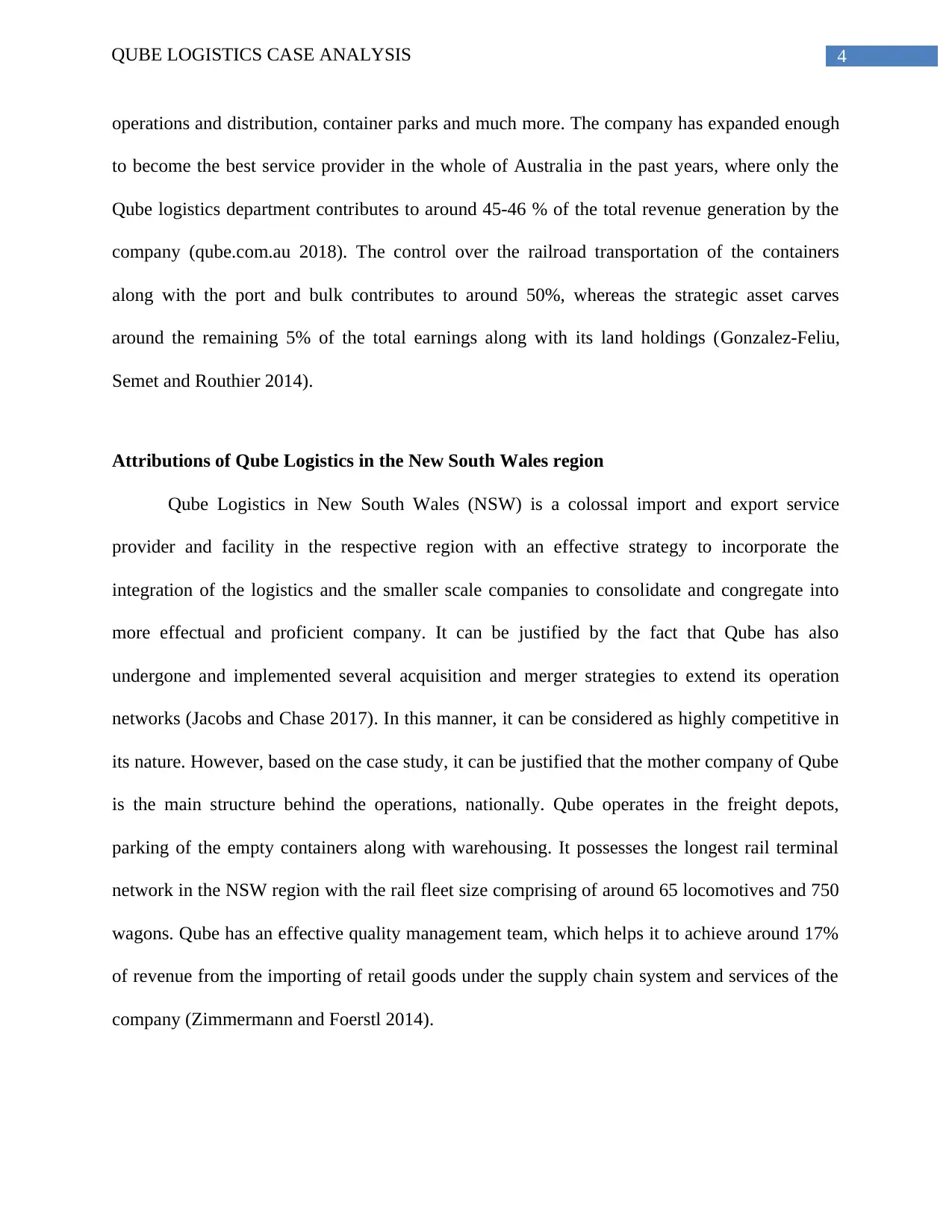
4QUBE LOGISTICS CASE ANALYSIS
operations and distribution, container parks and much more. The company has expanded enough
to become the best service provider in the whole of Australia in the past years, where only the
Qube logistics department contributes to around 45-46 % of the total revenue generation by the
company (qube.com.au 2018). The control over the railroad transportation of the containers
along with the port and bulk contributes to around 50%, whereas the strategic asset carves
around the remaining 5% of the total earnings along with its land holdings (Gonzalez-Feliu,
Semet and Routhier 2014).
Attributions of Qube Logistics in the New South Wales region
Qube Logistics in New South Wales (NSW) is a colossal import and export service
provider and facility in the respective region with an effective strategy to incorporate the
integration of the logistics and the smaller scale companies to consolidate and congregate into
more effectual and proficient company. It can be justified by the fact that Qube has also
undergone and implemented several acquisition and merger strategies to extend its operation
networks (Jacobs and Chase 2017). In this manner, it can be considered as highly competitive in
its nature. However, based on the case study, it can be justified that the mother company of Qube
is the main structure behind the operations, nationally. Qube operates in the freight depots,
parking of the empty containers along with warehousing. It possesses the longest rail terminal
network in the NSW region with the rail fleet size comprising of around 65 locomotives and 750
wagons. Qube has an effective quality management team, which helps it to achieve around 17%
of revenue from the importing of retail goods under the supply chain system and services of the
company (Zimmermann and Foerstl 2014).
operations and distribution, container parks and much more. The company has expanded enough
to become the best service provider in the whole of Australia in the past years, where only the
Qube logistics department contributes to around 45-46 % of the total revenue generation by the
company (qube.com.au 2018). The control over the railroad transportation of the containers
along with the port and bulk contributes to around 50%, whereas the strategic asset carves
around the remaining 5% of the total earnings along with its land holdings (Gonzalez-Feliu,
Semet and Routhier 2014).
Attributions of Qube Logistics in the New South Wales region
Qube Logistics in New South Wales (NSW) is a colossal import and export service
provider and facility in the respective region with an effective strategy to incorporate the
integration of the logistics and the smaller scale companies to consolidate and congregate into
more effectual and proficient company. It can be justified by the fact that Qube has also
undergone and implemented several acquisition and merger strategies to extend its operation
networks (Jacobs and Chase 2017). In this manner, it can be considered as highly competitive in
its nature. However, based on the case study, it can be justified that the mother company of Qube
is the main structure behind the operations, nationally. Qube operates in the freight depots,
parking of the empty containers along with warehousing. It possesses the longest rail terminal
network in the NSW region with the rail fleet size comprising of around 65 locomotives and 750
wagons. Qube has an effective quality management team, which helps it to achieve around 17%
of revenue from the importing of retail goods under the supply chain system and services of the
company (Zimmermann and Foerstl 2014).
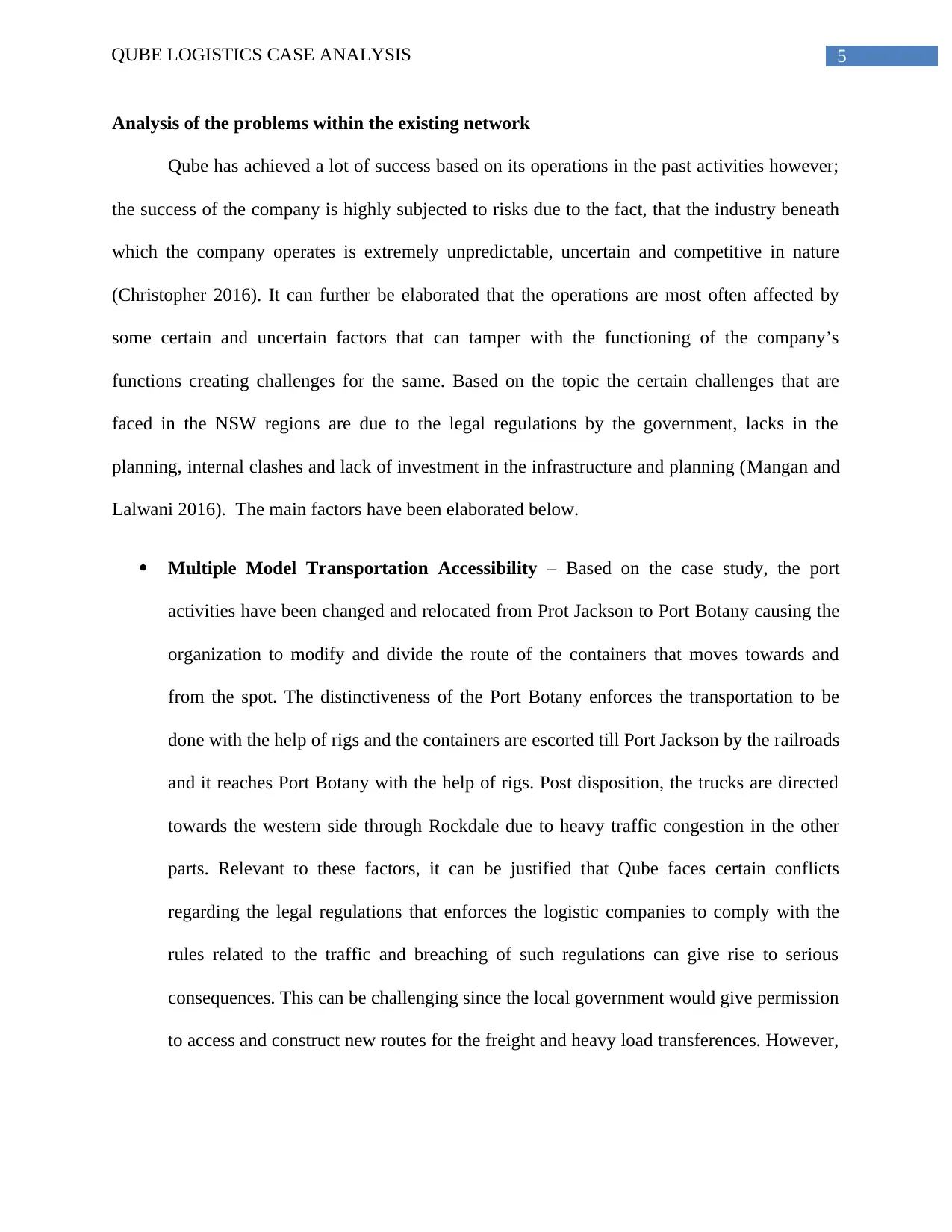
5QUBE LOGISTICS CASE ANALYSIS
Analysis of the problems within the existing network
Qube has achieved a lot of success based on its operations in the past activities however;
the success of the company is highly subjected to risks due to the fact, that the industry beneath
which the company operates is extremely unpredictable, uncertain and competitive in nature
(Christopher 2016). It can further be elaborated that the operations are most often affected by
some certain and uncertain factors that can tamper with the functioning of the company’s
functions creating challenges for the same. Based on the topic the certain challenges that are
faced in the NSW regions are due to the legal regulations by the government, lacks in the
planning, internal clashes and lack of investment in the infrastructure and planning (Mangan and
Lalwani 2016). The main factors have been elaborated below.
Multiple Model Transportation Accessibility – Based on the case study, the port
activities have been changed and relocated from Prot Jackson to Port Botany causing the
organization to modify and divide the route of the containers that moves towards and
from the spot. The distinctiveness of the Port Botany enforces the transportation to be
done with the help of rigs and the containers are escorted till Port Jackson by the railroads
and it reaches Port Botany with the help of rigs. Post disposition, the trucks are directed
towards the western side through Rockdale due to heavy traffic congestion in the other
parts. Relevant to these factors, it can be justified that Qube faces certain conflicts
regarding the legal regulations that enforces the logistic companies to comply with the
rules related to the traffic and breaching of such regulations can give rise to serious
consequences. This can be challenging since the local government would give permission
to access and construct new routes for the freight and heavy load transferences. However,
Analysis of the problems within the existing network
Qube has achieved a lot of success based on its operations in the past activities however;
the success of the company is highly subjected to risks due to the fact, that the industry beneath
which the company operates is extremely unpredictable, uncertain and competitive in nature
(Christopher 2016). It can further be elaborated that the operations are most often affected by
some certain and uncertain factors that can tamper with the functioning of the company’s
functions creating challenges for the same. Based on the topic the certain challenges that are
faced in the NSW regions are due to the legal regulations by the government, lacks in the
planning, internal clashes and lack of investment in the infrastructure and planning (Mangan and
Lalwani 2016). The main factors have been elaborated below.
Multiple Model Transportation Accessibility – Based on the case study, the port
activities have been changed and relocated from Prot Jackson to Port Botany causing the
organization to modify and divide the route of the containers that moves towards and
from the spot. The distinctiveness of the Port Botany enforces the transportation to be
done with the help of rigs and the containers are escorted till Port Jackson by the railroads
and it reaches Port Botany with the help of rigs. Post disposition, the trucks are directed
towards the western side through Rockdale due to heavy traffic congestion in the other
parts. Relevant to these factors, it can be justified that Qube faces certain conflicts
regarding the legal regulations that enforces the logistic companies to comply with the
rules related to the traffic and breaching of such regulations can give rise to serious
consequences. This can be challenging since the local government would give permission
to access and construct new routes for the freight and heavy load transferences. However,
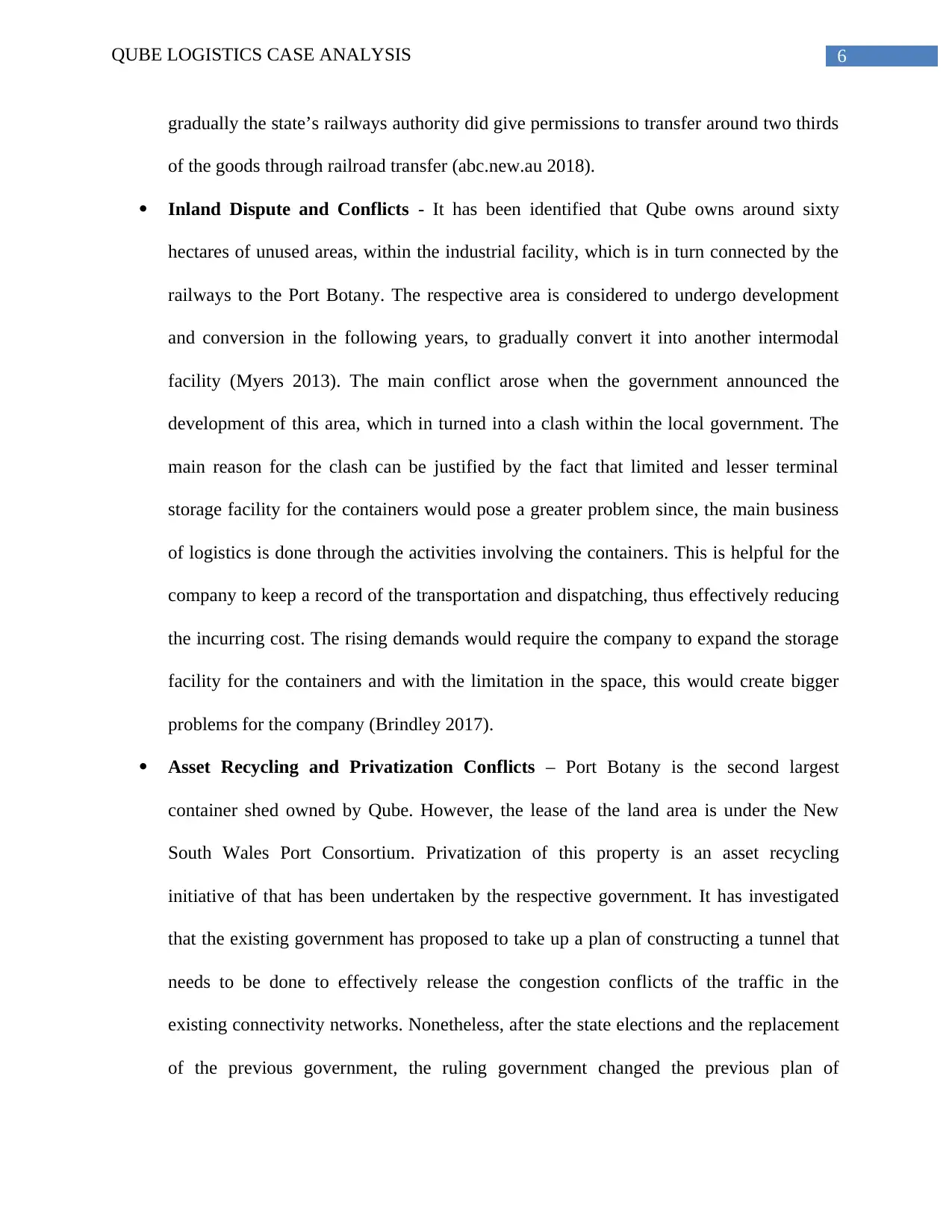
6QUBE LOGISTICS CASE ANALYSIS
gradually the state’s railways authority did give permissions to transfer around two thirds
of the goods through railroad transfer (abc.new.au 2018).
Inland Dispute and Conflicts - It has been identified that Qube owns around sixty
hectares of unused areas, within the industrial facility, which is in turn connected by the
railways to the Port Botany. The respective area is considered to undergo development
and conversion in the following years, to gradually convert it into another intermodal
facility (Myers 2013). The main conflict arose when the government announced the
development of this area, which in turned into a clash within the local government. The
main reason for the clash can be justified by the fact that limited and lesser terminal
storage facility for the containers would pose a greater problem since, the main business
of logistics is done through the activities involving the containers. This is helpful for the
company to keep a record of the transportation and dispatching, thus effectively reducing
the incurring cost. The rising demands would require the company to expand the storage
facility for the containers and with the limitation in the space, this would create bigger
problems for the company (Brindley 2017).
Asset Recycling and Privatization Conflicts – Port Botany is the second largest
container shed owned by Qube. However, the lease of the land area is under the New
South Wales Port Consortium. Privatization of this property is an asset recycling
initiative of that has been undertaken by the respective government. It has investigated
that the existing government has proposed to take up a plan of constructing a tunnel that
needs to be done to effectively release the congestion conflicts of the traffic in the
existing connectivity networks. Nonetheless, after the state elections and the replacement
of the previous government, the ruling government changed the previous plan of
gradually the state’s railways authority did give permissions to transfer around two thirds
of the goods through railroad transfer (abc.new.au 2018).
Inland Dispute and Conflicts - It has been identified that Qube owns around sixty
hectares of unused areas, within the industrial facility, which is in turn connected by the
railways to the Port Botany. The respective area is considered to undergo development
and conversion in the following years, to gradually convert it into another intermodal
facility (Myers 2013). The main conflict arose when the government announced the
development of this area, which in turned into a clash within the local government. The
main reason for the clash can be justified by the fact that limited and lesser terminal
storage facility for the containers would pose a greater problem since, the main business
of logistics is done through the activities involving the containers. This is helpful for the
company to keep a record of the transportation and dispatching, thus effectively reducing
the incurring cost. The rising demands would require the company to expand the storage
facility for the containers and with the limitation in the space, this would create bigger
problems for the company (Brindley 2017).
Asset Recycling and Privatization Conflicts – Port Botany is the second largest
container shed owned by Qube. However, the lease of the land area is under the New
South Wales Port Consortium. Privatization of this property is an asset recycling
initiative of that has been undertaken by the respective government. It has investigated
that the existing government has proposed to take up a plan of constructing a tunnel that
needs to be done to effectively release the congestion conflicts of the traffic in the
existing connectivity networks. Nonetheless, after the state elections and the replacement
of the previous government, the ruling government changed the previous plan of
Paraphrase This Document
Need a fresh take? Get an instant paraphrase of this document with our AI Paraphraser
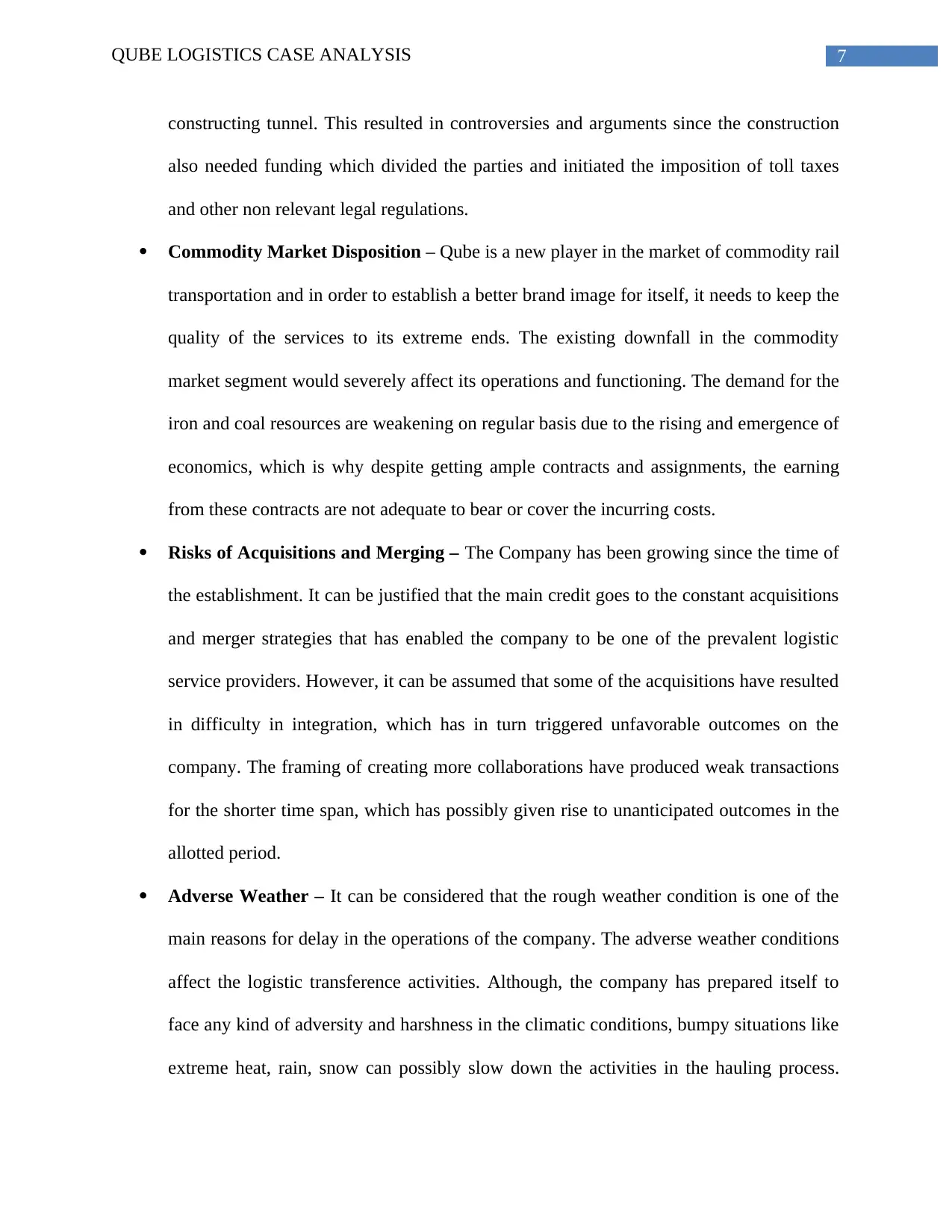
7QUBE LOGISTICS CASE ANALYSIS
constructing tunnel. This resulted in controversies and arguments since the construction
also needed funding which divided the parties and initiated the imposition of toll taxes
and other non relevant legal regulations.
Commodity Market Disposition – Qube is a new player in the market of commodity rail
transportation and in order to establish a better brand image for itself, it needs to keep the
quality of the services to its extreme ends. The existing downfall in the commodity
market segment would severely affect its operations and functioning. The demand for the
iron and coal resources are weakening on regular basis due to the rising and emergence of
economics, which is why despite getting ample contracts and assignments, the earning
from these contracts are not adequate to bear or cover the incurring costs.
Risks of Acquisitions and Merging – The Company has been growing since the time of
the establishment. It can be justified that the main credit goes to the constant acquisitions
and merger strategies that has enabled the company to be one of the prevalent logistic
service providers. However, it can be assumed that some of the acquisitions have resulted
in difficulty in integration, which has in turn triggered unfavorable outcomes on the
company. The framing of creating more collaborations have produced weak transactions
for the shorter time span, which has possibly given rise to unanticipated outcomes in the
allotted period.
Adverse Weather – It can be considered that the rough weather condition is one of the
main reasons for delay in the operations of the company. The adverse weather conditions
affect the logistic transference activities. Although, the company has prepared itself to
face any kind of adversity and harshness in the climatic conditions, bumpy situations like
extreme heat, rain, snow can possibly slow down the activities in the hauling process.
constructing tunnel. This resulted in controversies and arguments since the construction
also needed funding which divided the parties and initiated the imposition of toll taxes
and other non relevant legal regulations.
Commodity Market Disposition – Qube is a new player in the market of commodity rail
transportation and in order to establish a better brand image for itself, it needs to keep the
quality of the services to its extreme ends. The existing downfall in the commodity
market segment would severely affect its operations and functioning. The demand for the
iron and coal resources are weakening on regular basis due to the rising and emergence of
economics, which is why despite getting ample contracts and assignments, the earning
from these contracts are not adequate to bear or cover the incurring costs.
Risks of Acquisitions and Merging – The Company has been growing since the time of
the establishment. It can be justified that the main credit goes to the constant acquisitions
and merger strategies that has enabled the company to be one of the prevalent logistic
service providers. However, it can be assumed that some of the acquisitions have resulted
in difficulty in integration, which has in turn triggered unfavorable outcomes on the
company. The framing of creating more collaborations have produced weak transactions
for the shorter time span, which has possibly given rise to unanticipated outcomes in the
allotted period.
Adverse Weather – It can be considered that the rough weather condition is one of the
main reasons for delay in the operations of the company. The adverse weather conditions
affect the logistic transference activities. Although, the company has prepared itself to
face any kind of adversity and harshness in the climatic conditions, bumpy situations like
extreme heat, rain, snow can possibly slow down the activities in the hauling process.
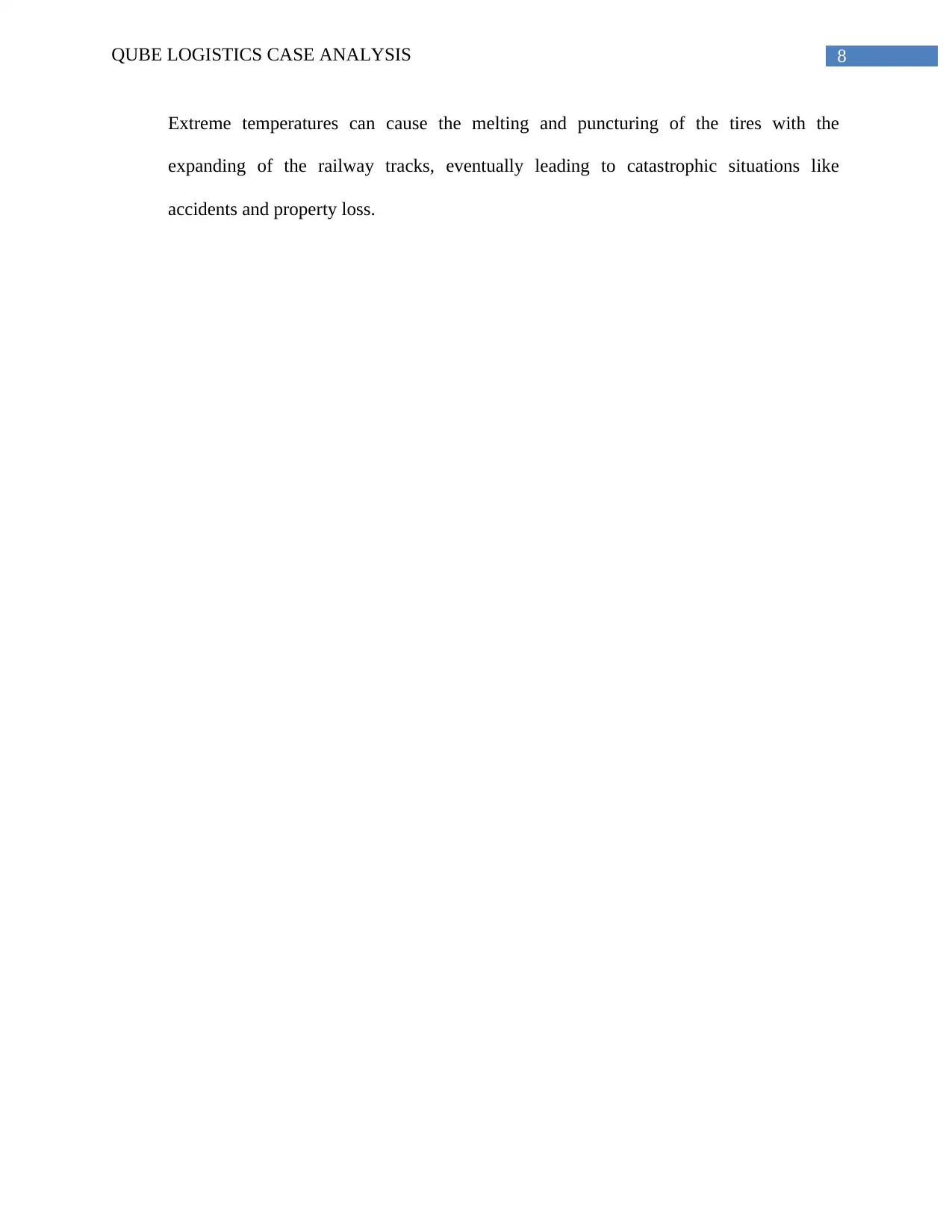
8QUBE LOGISTICS CASE ANALYSIS
Extreme temperatures can cause the melting and puncturing of the tires with the
expanding of the railway tracks, eventually leading to catastrophic situations like
accidents and property loss.
Extreme temperatures can cause the melting and puncturing of the tires with the
expanding of the railway tracks, eventually leading to catastrophic situations like
accidents and property loss.
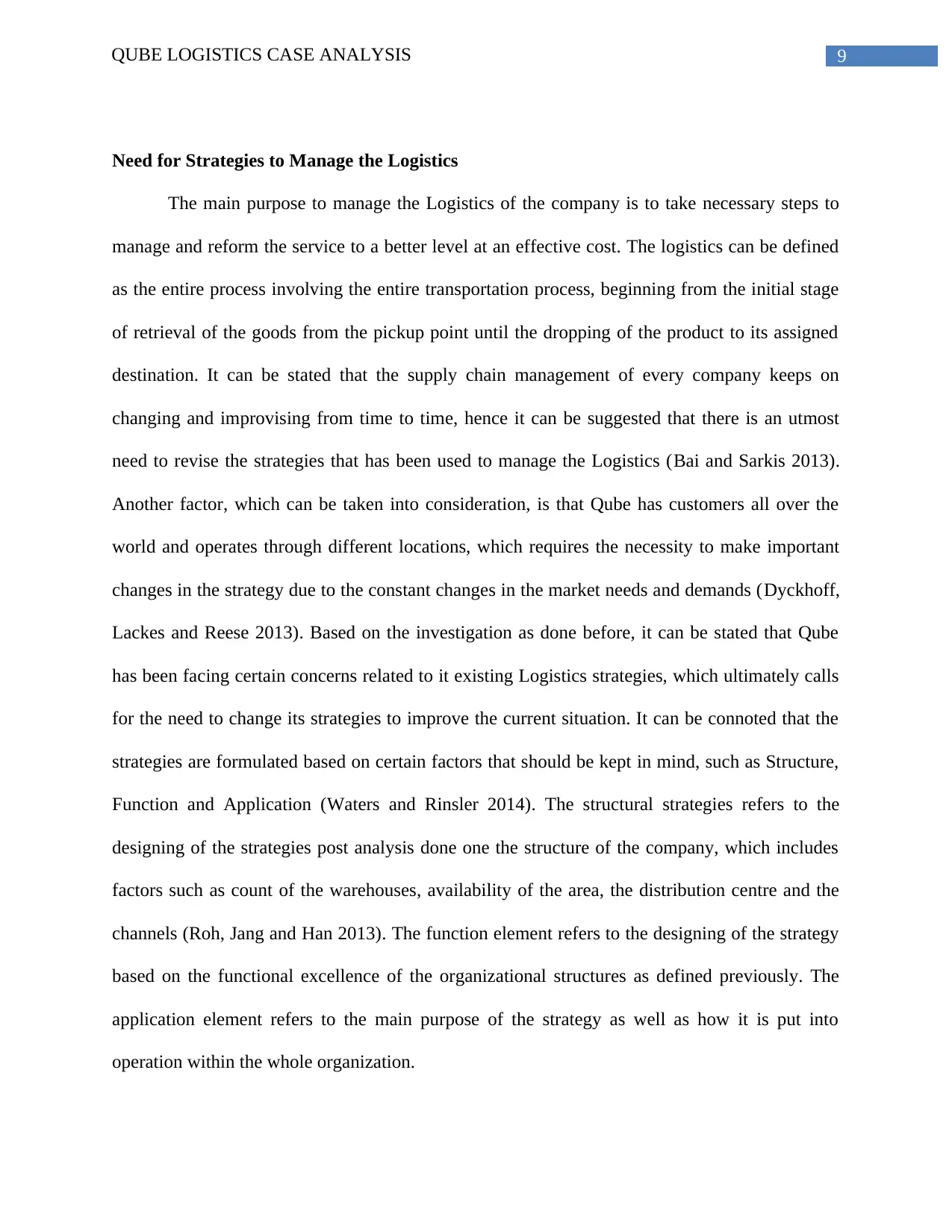
9QUBE LOGISTICS CASE ANALYSIS
Need for Strategies to Manage the Logistics
The main purpose to manage the Logistics of the company is to take necessary steps to
manage and reform the service to a better level at an effective cost. The logistics can be defined
as the entire process involving the entire transportation process, beginning from the initial stage
of retrieval of the goods from the pickup point until the dropping of the product to its assigned
destination. It can be stated that the supply chain management of every company keeps on
changing and improvising from time to time, hence it can be suggested that there is an utmost
need to revise the strategies that has been used to manage the Logistics (Bai and Sarkis 2013).
Another factor, which can be taken into consideration, is that Qube has customers all over the
world and operates through different locations, which requires the necessity to make important
changes in the strategy due to the constant changes in the market needs and demands (Dyckhoff,
Lackes and Reese 2013). Based on the investigation as done before, it can be stated that Qube
has been facing certain concerns related to it existing Logistics strategies, which ultimately calls
for the need to change its strategies to improve the current situation. It can be connoted that the
strategies are formulated based on certain factors that should be kept in mind, such as Structure,
Function and Application (Waters and Rinsler 2014). The structural strategies refers to the
designing of the strategies post analysis done one the structure of the company, which includes
factors such as count of the warehouses, availability of the area, the distribution centre and the
channels (Roh, Jang and Han 2013). The function element refers to the designing of the strategy
based on the functional excellence of the organizational structures as defined previously. The
application element refers to the main purpose of the strategy as well as how it is put into
operation within the whole organization.
Need for Strategies to Manage the Logistics
The main purpose to manage the Logistics of the company is to take necessary steps to
manage and reform the service to a better level at an effective cost. The logistics can be defined
as the entire process involving the entire transportation process, beginning from the initial stage
of retrieval of the goods from the pickup point until the dropping of the product to its assigned
destination. It can be stated that the supply chain management of every company keeps on
changing and improvising from time to time, hence it can be suggested that there is an utmost
need to revise the strategies that has been used to manage the Logistics (Bai and Sarkis 2013).
Another factor, which can be taken into consideration, is that Qube has customers all over the
world and operates through different locations, which requires the necessity to make important
changes in the strategy due to the constant changes in the market needs and demands (Dyckhoff,
Lackes and Reese 2013). Based on the investigation as done before, it can be stated that Qube
has been facing certain concerns related to it existing Logistics strategies, which ultimately calls
for the need to change its strategies to improve the current situation. It can be connoted that the
strategies are formulated based on certain factors that should be kept in mind, such as Structure,
Function and Application (Waters and Rinsler 2014). The structural strategies refers to the
designing of the strategies post analysis done one the structure of the company, which includes
factors such as count of the warehouses, availability of the area, the distribution centre and the
channels (Roh, Jang and Han 2013). The function element refers to the designing of the strategy
based on the functional excellence of the organizational structures as defined previously. The
application element refers to the main purpose of the strategy as well as how it is put into
operation within the whole organization.
Secure Best Marks with AI Grader
Need help grading? Try our AI Grader for instant feedback on your assignments.

10QUBE LOGISTICS CASE ANALYSIS
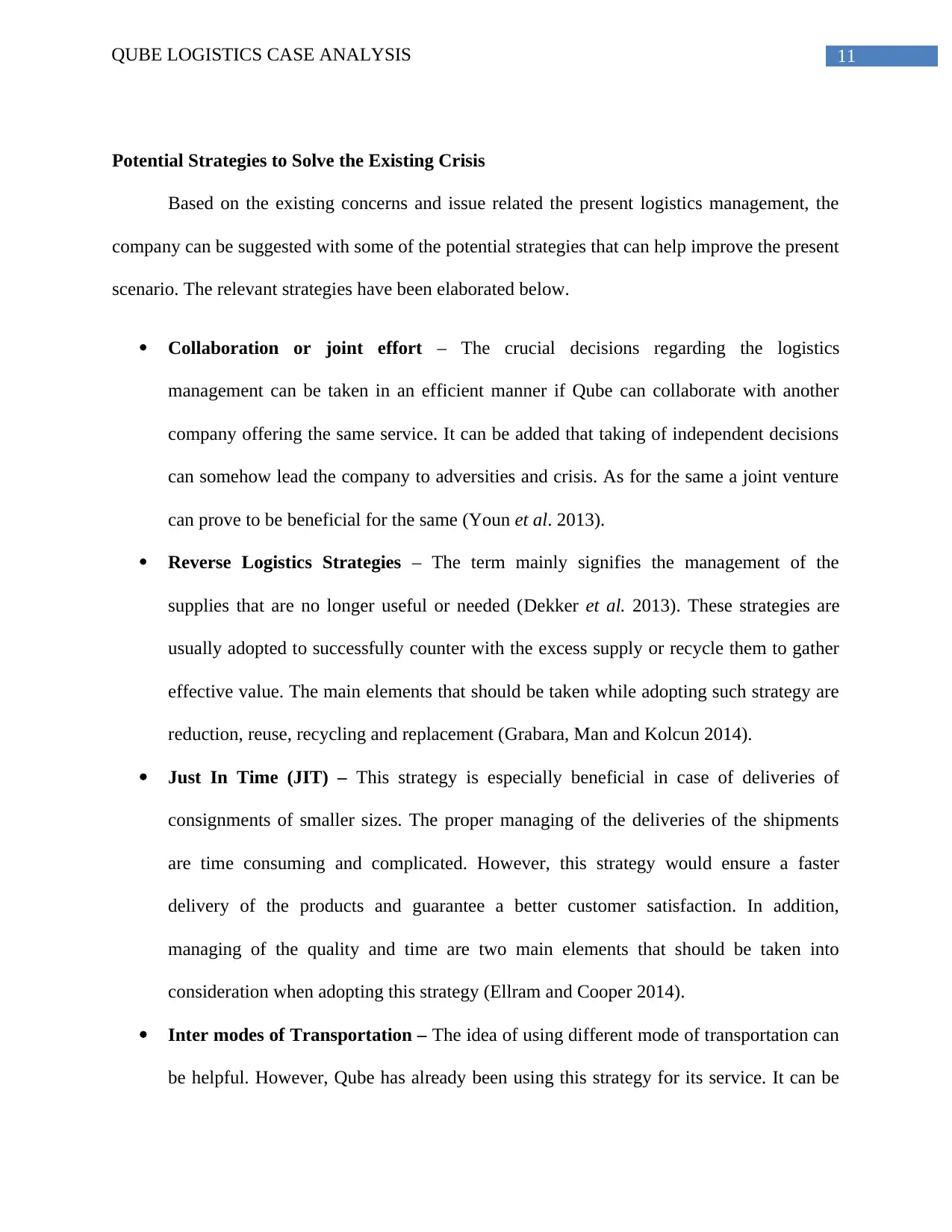
11QUBE LOGISTICS CASE ANALYSIS
Potential Strategies to Solve the Existing Crisis
Based on the existing concerns and issue related the present logistics management, the
company can be suggested with some of the potential strategies that can help improve the present
scenario. The relevant strategies have been elaborated below.
Collaboration or joint effort – The crucial decisions regarding the logistics
management can be taken in an efficient manner if Qube can collaborate with another
company offering the same service. It can be added that taking of independent decisions
can somehow lead the company to adversities and crisis. As for the same a joint venture
can prove to be beneficial for the same (Youn et al. 2013).
Reverse Logistics Strategies – The term mainly signifies the management of the
supplies that are no longer useful or needed (Dekker et al. 2013). These strategies are
usually adopted to successfully counter with the excess supply or recycle them to gather
effective value. The main elements that should be taken while adopting such strategy are
reduction, reuse, recycling and replacement (Grabara, Man and Kolcun 2014).
Just In Time (JIT) – This strategy is especially beneficial in case of deliveries of
consignments of smaller sizes. The proper managing of the deliveries of the shipments
are time consuming and complicated. However, this strategy would ensure a faster
delivery of the products and guarantee a better customer satisfaction. In addition,
managing of the quality and time are two main elements that should be taken into
consideration when adopting this strategy (Ellram and Cooper 2014).
Inter modes of Transportation – The idea of using different mode of transportation can
be helpful. However, Qube has already been using this strategy for its service. It can be
Potential Strategies to Solve the Existing Crisis
Based on the existing concerns and issue related the present logistics management, the
company can be suggested with some of the potential strategies that can help improve the present
scenario. The relevant strategies have been elaborated below.
Collaboration or joint effort – The crucial decisions regarding the logistics
management can be taken in an efficient manner if Qube can collaborate with another
company offering the same service. It can be added that taking of independent decisions
can somehow lead the company to adversities and crisis. As for the same a joint venture
can prove to be beneficial for the same (Youn et al. 2013).
Reverse Logistics Strategies – The term mainly signifies the management of the
supplies that are no longer useful or needed (Dekker et al. 2013). These strategies are
usually adopted to successfully counter with the excess supply or recycle them to gather
effective value. The main elements that should be taken while adopting such strategy are
reduction, reuse, recycling and replacement (Grabara, Man and Kolcun 2014).
Just In Time (JIT) – This strategy is especially beneficial in case of deliveries of
consignments of smaller sizes. The proper managing of the deliveries of the shipments
are time consuming and complicated. However, this strategy would ensure a faster
delivery of the products and guarantee a better customer satisfaction. In addition,
managing of the quality and time are two main elements that should be taken into
consideration when adopting this strategy (Ellram and Cooper 2014).
Inter modes of Transportation – The idea of using different mode of transportation can
be helpful. However, Qube has already been using this strategy for its service. It can be
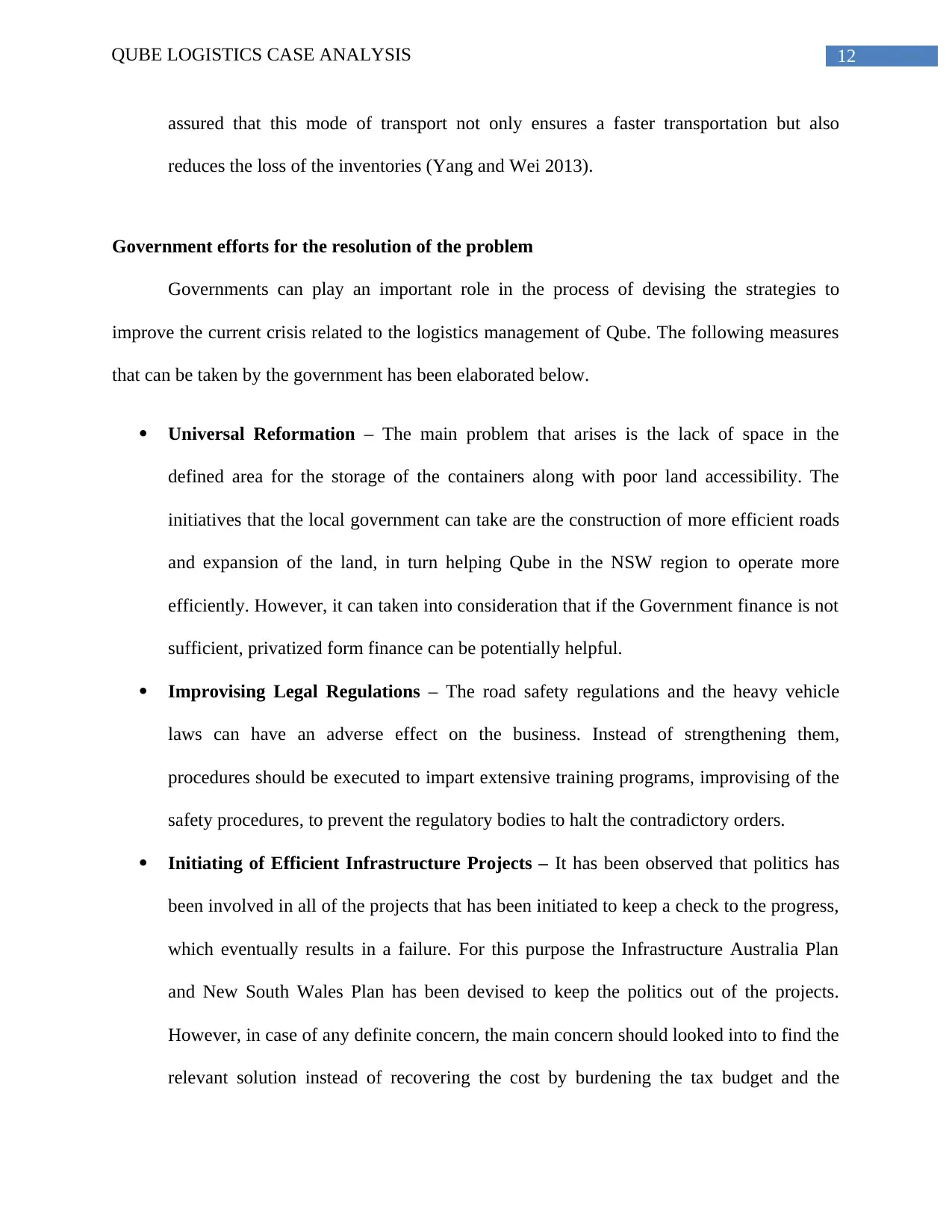
12QUBE LOGISTICS CASE ANALYSIS
assured that this mode of transport not only ensures a faster transportation but also
reduces the loss of the inventories (Yang and Wei 2013).
Government efforts for the resolution of the problem
Governments can play an important role in the process of devising the strategies to
improve the current crisis related to the logistics management of Qube. The following measures
that can be taken by the government has been elaborated below.
Universal Reformation – The main problem that arises is the lack of space in the
defined area for the storage of the containers along with poor land accessibility. The
initiatives that the local government can take are the construction of more efficient roads
and expansion of the land, in turn helping Qube in the NSW region to operate more
efficiently. However, it can taken into consideration that if the Government finance is not
sufficient, privatized form finance can be potentially helpful.
Improvising Legal Regulations – The road safety regulations and the heavy vehicle
laws can have an adverse effect on the business. Instead of strengthening them,
procedures should be executed to impart extensive training programs, improvising of the
safety procedures, to prevent the regulatory bodies to halt the contradictory orders.
Initiating of Efficient Infrastructure Projects – It has been observed that politics has
been involved in all of the projects that has been initiated to keep a check to the progress,
which eventually results in a failure. For this purpose the Infrastructure Australia Plan
and New South Wales Plan has been devised to keep the politics out of the projects.
However, in case of any definite concern, the main concern should looked into to find the
relevant solution instead of recovering the cost by burdening the tax budget and the
assured that this mode of transport not only ensures a faster transportation but also
reduces the loss of the inventories (Yang and Wei 2013).
Government efforts for the resolution of the problem
Governments can play an important role in the process of devising the strategies to
improve the current crisis related to the logistics management of Qube. The following measures
that can be taken by the government has been elaborated below.
Universal Reformation – The main problem that arises is the lack of space in the
defined area for the storage of the containers along with poor land accessibility. The
initiatives that the local government can take are the construction of more efficient roads
and expansion of the land, in turn helping Qube in the NSW region to operate more
efficiently. However, it can taken into consideration that if the Government finance is not
sufficient, privatized form finance can be potentially helpful.
Improvising Legal Regulations – The road safety regulations and the heavy vehicle
laws can have an adverse effect on the business. Instead of strengthening them,
procedures should be executed to impart extensive training programs, improvising of the
safety procedures, to prevent the regulatory bodies to halt the contradictory orders.
Initiating of Efficient Infrastructure Projects – It has been observed that politics has
been involved in all of the projects that has been initiated to keep a check to the progress,
which eventually results in a failure. For this purpose the Infrastructure Australia Plan
and New South Wales Plan has been devised to keep the politics out of the projects.
However, in case of any definite concern, the main concern should looked into to find the
relevant solution instead of recovering the cost by burdening the tax budget and the
Paraphrase This Document
Need a fresh take? Get an instant paraphrase of this document with our AI Paraphraser
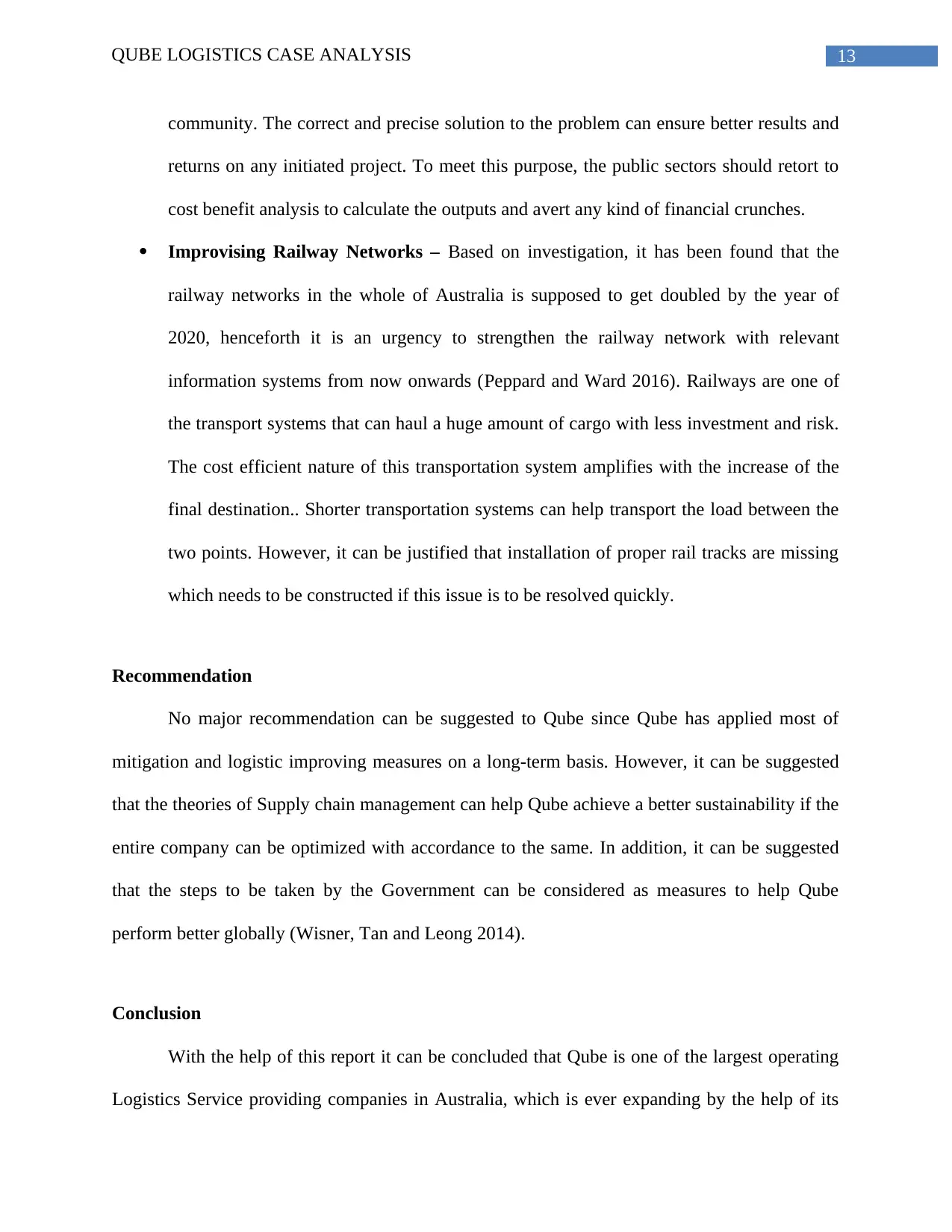
13QUBE LOGISTICS CASE ANALYSIS
community. The correct and precise solution to the problem can ensure better results and
returns on any initiated project. To meet this purpose, the public sectors should retort to
cost benefit analysis to calculate the outputs and avert any kind of financial crunches.
Improvising Railway Networks – Based on investigation, it has been found that the
railway networks in the whole of Australia is supposed to get doubled by the year of
2020, henceforth it is an urgency to strengthen the railway network with relevant
information systems from now onwards (Peppard and Ward 2016). Railways are one of
the transport systems that can haul a huge amount of cargo with less investment and risk.
The cost efficient nature of this transportation system amplifies with the increase of the
final destination.. Shorter transportation systems can help transport the load between the
two points. However, it can be justified that installation of proper rail tracks are missing
which needs to be constructed if this issue is to be resolved quickly.
Recommendation
No major recommendation can be suggested to Qube since Qube has applied most of
mitigation and logistic improving measures on a long-term basis. However, it can be suggested
that the theories of Supply chain management can help Qube achieve a better sustainability if the
entire company can be optimized with accordance to the same. In addition, it can be suggested
that the steps to be taken by the Government can be considered as measures to help Qube
perform better globally (Wisner, Tan and Leong 2014).
Conclusion
With the help of this report it can be concluded that Qube is one of the largest operating
Logistics Service providing companies in Australia, which is ever expanding by the help of its
community. The correct and precise solution to the problem can ensure better results and
returns on any initiated project. To meet this purpose, the public sectors should retort to
cost benefit analysis to calculate the outputs and avert any kind of financial crunches.
Improvising Railway Networks – Based on investigation, it has been found that the
railway networks in the whole of Australia is supposed to get doubled by the year of
2020, henceforth it is an urgency to strengthen the railway network with relevant
information systems from now onwards (Peppard and Ward 2016). Railways are one of
the transport systems that can haul a huge amount of cargo with less investment and risk.
The cost efficient nature of this transportation system amplifies with the increase of the
final destination.. Shorter transportation systems can help transport the load between the
two points. However, it can be justified that installation of proper rail tracks are missing
which needs to be constructed if this issue is to be resolved quickly.
Recommendation
No major recommendation can be suggested to Qube since Qube has applied most of
mitigation and logistic improving measures on a long-term basis. However, it can be suggested
that the theories of Supply chain management can help Qube achieve a better sustainability if the
entire company can be optimized with accordance to the same. In addition, it can be suggested
that the steps to be taken by the Government can be considered as measures to help Qube
perform better globally (Wisner, Tan and Leong 2014).
Conclusion
With the help of this report it can be concluded that Qube is one of the largest operating
Logistics Service providing companies in Australia, which is ever expanding by the help of its
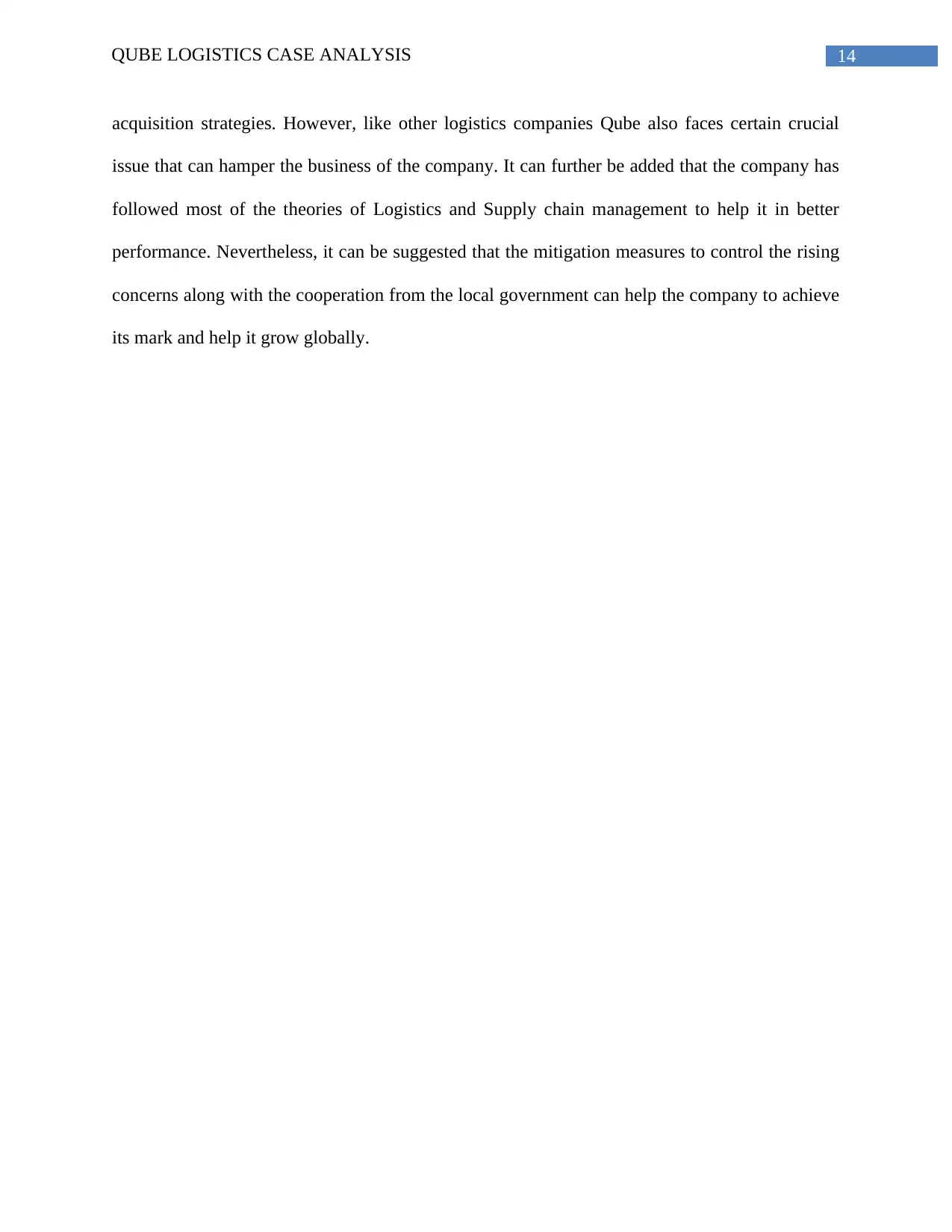
14QUBE LOGISTICS CASE ANALYSIS
acquisition strategies. However, like other logistics companies Qube also faces certain crucial
issue that can hamper the business of the company. It can further be added that the company has
followed most of the theories of Logistics and Supply chain management to help it in better
performance. Nevertheless, it can be suggested that the mitigation measures to control the rising
concerns along with the cooperation from the local government can help the company to achieve
its mark and help it grow globally.
acquisition strategies. However, like other logistics companies Qube also faces certain crucial
issue that can hamper the business of the company. It can further be added that the company has
followed most of the theories of Logistics and Supply chain management to help it in better
performance. Nevertheless, it can be suggested that the mitigation measures to control the rising
concerns along with the cooperation from the local government can help the company to achieve
its mark and help it grow globally.
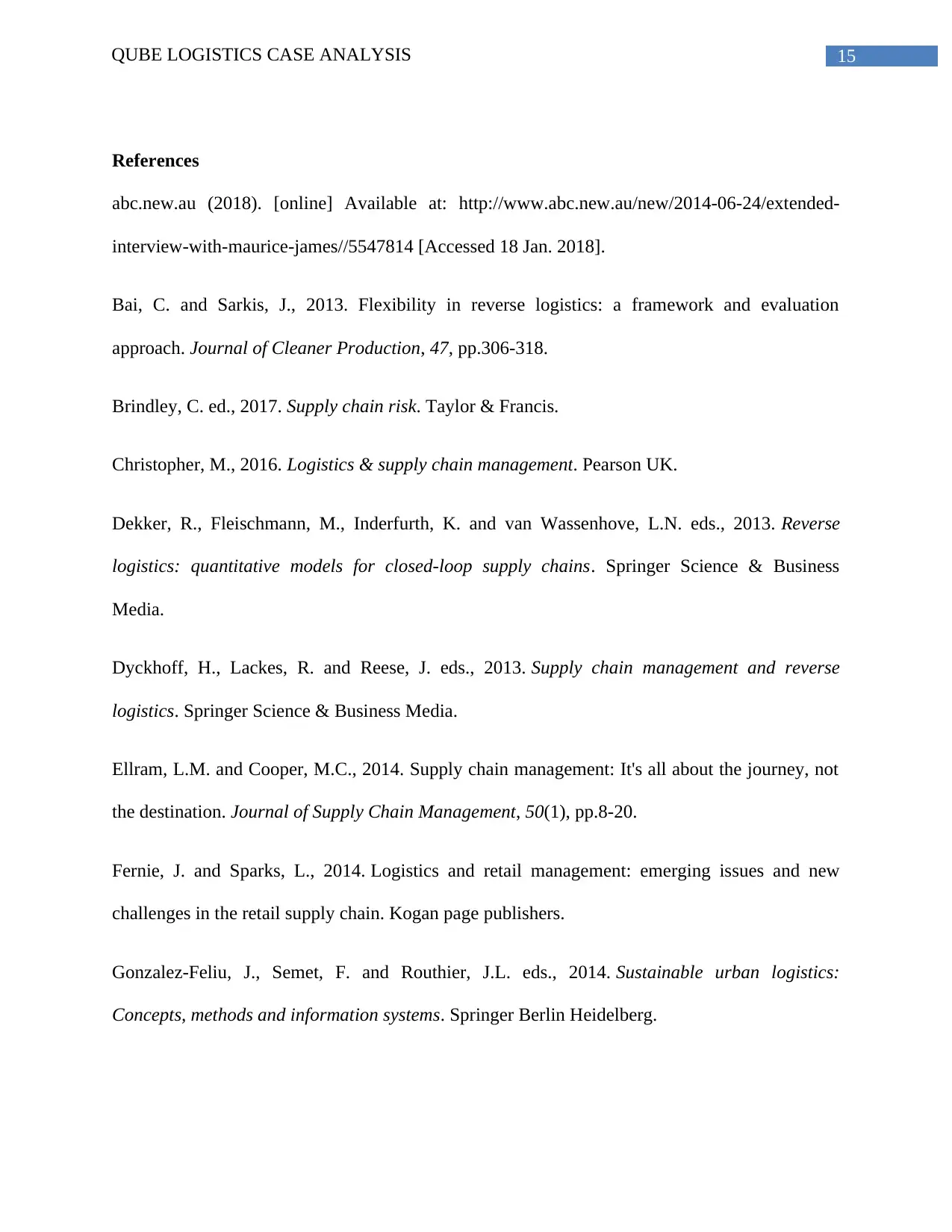
15QUBE LOGISTICS CASE ANALYSIS
References
abc.new.au (2018). [online] Available at: http://www.abc.new.au/new/2014-06-24/extended-
interview-with-maurice-james//5547814 [Accessed 18 Jan. 2018].
Bai, C. and Sarkis, J., 2013. Flexibility in reverse logistics: a framework and evaluation
approach. Journal of Cleaner Production, 47, pp.306-318.
Brindley, C. ed., 2017. Supply chain risk. Taylor & Francis.
Christopher, M., 2016. Logistics & supply chain management. Pearson UK.
Dekker, R., Fleischmann, M., Inderfurth, K. and van Wassenhove, L.N. eds., 2013. Reverse
logistics: quantitative models for closed-loop supply chains. Springer Science & Business
Media.
Dyckhoff, H., Lackes, R. and Reese, J. eds., 2013. Supply chain management and reverse
logistics. Springer Science & Business Media.
Ellram, L.M. and Cooper, M.C., 2014. Supply chain management: It's all about the journey, not
the destination. Journal of Supply Chain Management, 50(1), pp.8-20.
Fernie, J. and Sparks, L., 2014. Logistics and retail management: emerging issues and new
challenges in the retail supply chain. Kogan page publishers.
Gonzalez-Feliu, J., Semet, F. and Routhier, J.L. eds., 2014. Sustainable urban logistics:
Concepts, methods and information systems. Springer Berlin Heidelberg.
References
abc.new.au (2018). [online] Available at: http://www.abc.new.au/new/2014-06-24/extended-
interview-with-maurice-james//5547814 [Accessed 18 Jan. 2018].
Bai, C. and Sarkis, J., 2013. Flexibility in reverse logistics: a framework and evaluation
approach. Journal of Cleaner Production, 47, pp.306-318.
Brindley, C. ed., 2017. Supply chain risk. Taylor & Francis.
Christopher, M., 2016. Logistics & supply chain management. Pearson UK.
Dekker, R., Fleischmann, M., Inderfurth, K. and van Wassenhove, L.N. eds., 2013. Reverse
logistics: quantitative models for closed-loop supply chains. Springer Science & Business
Media.
Dyckhoff, H., Lackes, R. and Reese, J. eds., 2013. Supply chain management and reverse
logistics. Springer Science & Business Media.
Ellram, L.M. and Cooper, M.C., 2014. Supply chain management: It's all about the journey, not
the destination. Journal of Supply Chain Management, 50(1), pp.8-20.
Fernie, J. and Sparks, L., 2014. Logistics and retail management: emerging issues and new
challenges in the retail supply chain. Kogan page publishers.
Gonzalez-Feliu, J., Semet, F. and Routhier, J.L. eds., 2014. Sustainable urban logistics:
Concepts, methods and information systems. Springer Berlin Heidelberg.
Secure Best Marks with AI Grader
Need help grading? Try our AI Grader for instant feedback on your assignments.
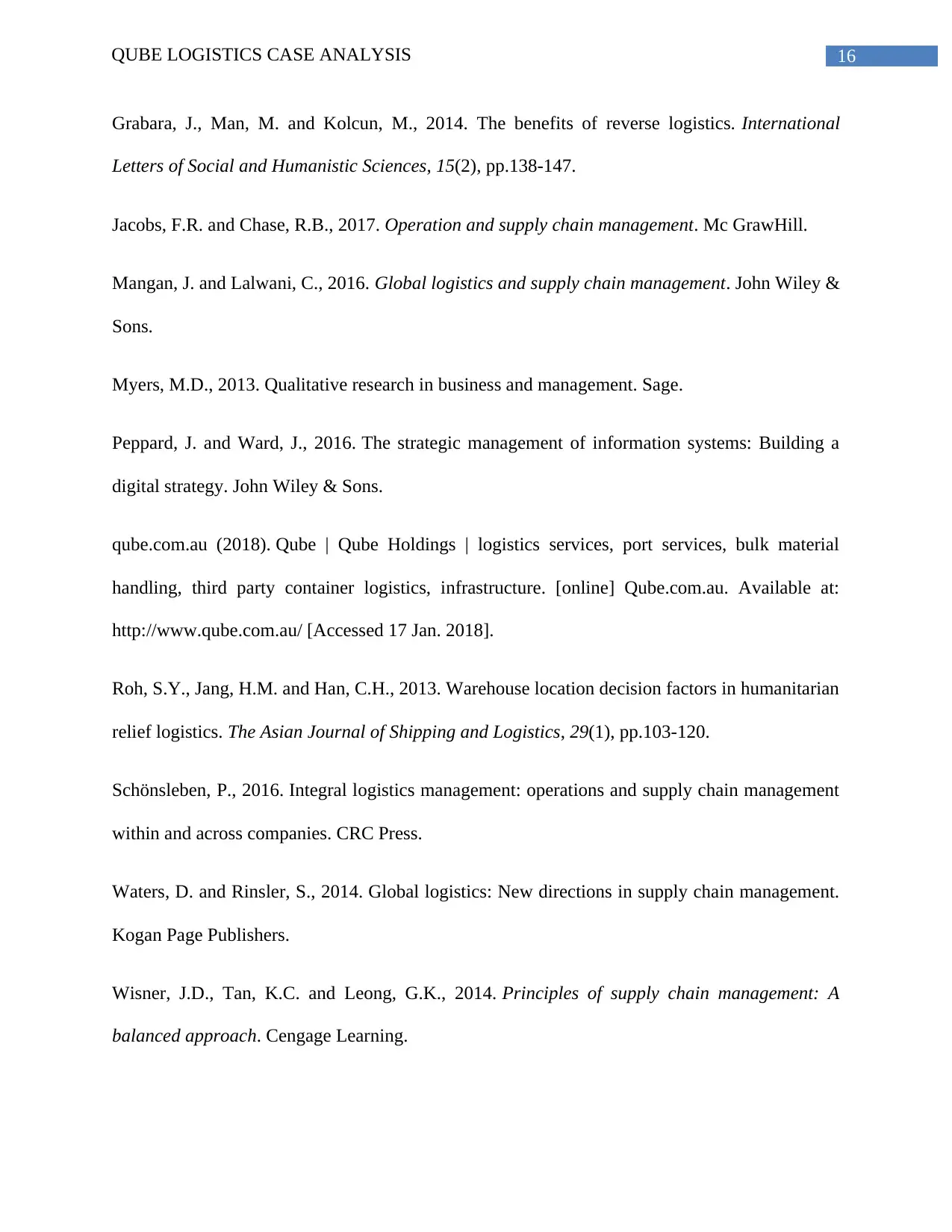
16QUBE LOGISTICS CASE ANALYSIS
Grabara, J., Man, M. and Kolcun, M., 2014. The benefits of reverse logistics. International
Letters of Social and Humanistic Sciences, 15(2), pp.138-147.
Jacobs, F.R. and Chase, R.B., 2017. Operation and supply chain management. Mc GrawHill.
Mangan, J. and Lalwani, C., 2016. Global logistics and supply chain management. John Wiley &
Sons.
Myers, M.D., 2013. Qualitative research in business and management. Sage.
Peppard, J. and Ward, J., 2016. The strategic management of information systems: Building a
digital strategy. John Wiley & Sons.
qube.com.au (2018). Qube | Qube Holdings | logistics services, port services, bulk material
handling, third party container logistics, infrastructure. [online] Qube.com.au. Available at:
http://www.qube.com.au/ [Accessed 17 Jan. 2018].
Roh, S.Y., Jang, H.M. and Han, C.H., 2013. Warehouse location decision factors in humanitarian
relief logistics. The Asian Journal of Shipping and Logistics, 29(1), pp.103-120.
Schönsleben, P., 2016. Integral logistics management: operations and supply chain management
within and across companies. CRC Press.
Waters, D. and Rinsler, S., 2014. Global logistics: New directions in supply chain management.
Kogan Page Publishers.
Wisner, J.D., Tan, K.C. and Leong, G.K., 2014. Principles of supply chain management: A
balanced approach. Cengage Learning.
Grabara, J., Man, M. and Kolcun, M., 2014. The benefits of reverse logistics. International
Letters of Social and Humanistic Sciences, 15(2), pp.138-147.
Jacobs, F.R. and Chase, R.B., 2017. Operation and supply chain management. Mc GrawHill.
Mangan, J. and Lalwani, C., 2016. Global logistics and supply chain management. John Wiley &
Sons.
Myers, M.D., 2013. Qualitative research in business and management. Sage.
Peppard, J. and Ward, J., 2016. The strategic management of information systems: Building a
digital strategy. John Wiley & Sons.
qube.com.au (2018). Qube | Qube Holdings | logistics services, port services, bulk material
handling, third party container logistics, infrastructure. [online] Qube.com.au. Available at:
http://www.qube.com.au/ [Accessed 17 Jan. 2018].
Roh, S.Y., Jang, H.M. and Han, C.H., 2013. Warehouse location decision factors in humanitarian
relief logistics. The Asian Journal of Shipping and Logistics, 29(1), pp.103-120.
Schönsleben, P., 2016. Integral logistics management: operations and supply chain management
within and across companies. CRC Press.
Waters, D. and Rinsler, S., 2014. Global logistics: New directions in supply chain management.
Kogan Page Publishers.
Wisner, J.D., Tan, K.C. and Leong, G.K., 2014. Principles of supply chain management: A
balanced approach. Cengage Learning.
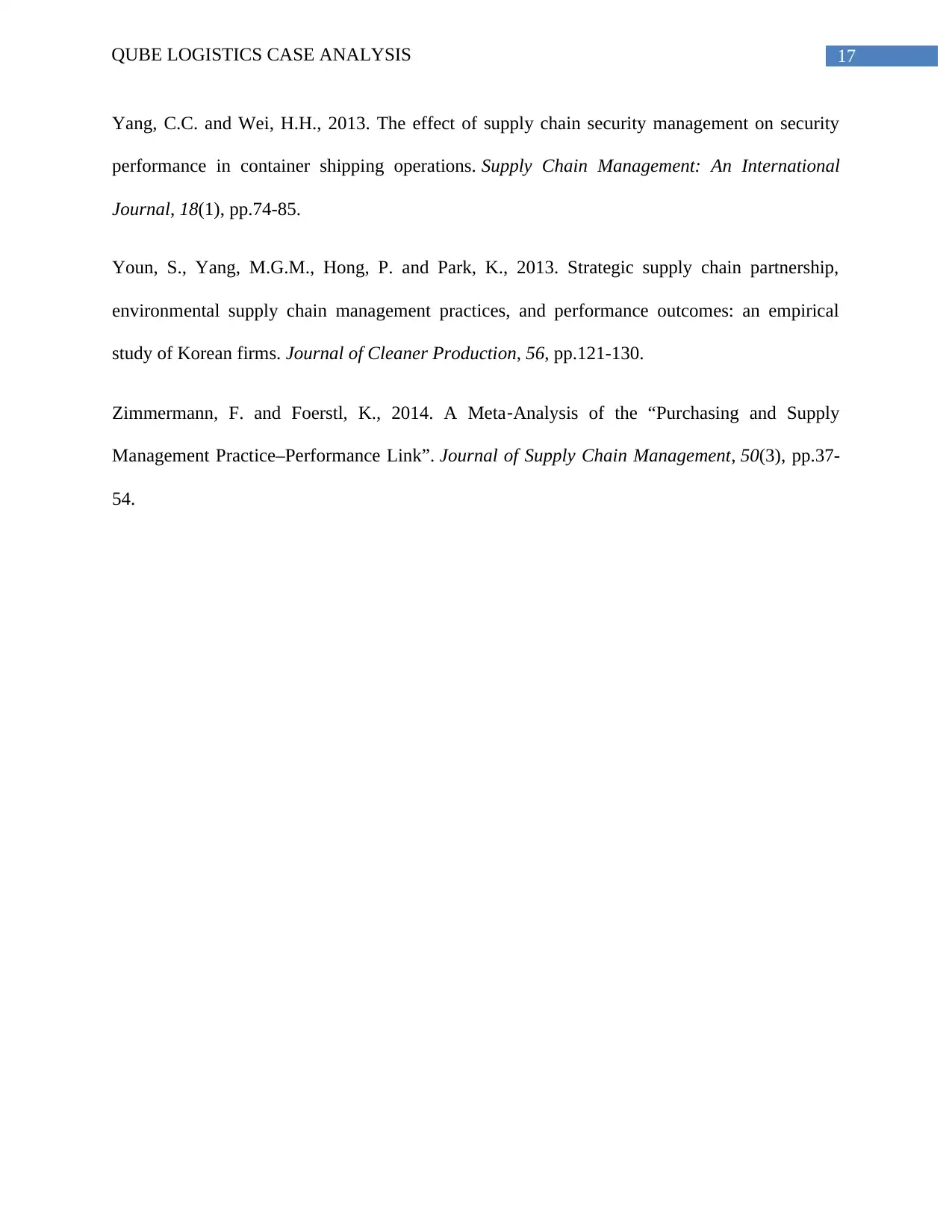
17QUBE LOGISTICS CASE ANALYSIS
Yang, C.C. and Wei, H.H., 2013. The effect of supply chain security management on security
performance in container shipping operations. Supply Chain Management: An International
Journal, 18(1), pp.74-85.
Youn, S., Yang, M.G.M., Hong, P. and Park, K., 2013. Strategic supply chain partnership,
environmental supply chain management practices, and performance outcomes: an empirical
study of Korean firms. Journal of Cleaner Production, 56, pp.121-130.
Zimmermann, F. and Foerstl, K., 2014. A Meta‐Analysis of the “Purchasing and Supply
Management Practice–Performance Link”. Journal of Supply Chain Management, 50(3), pp.37-
54.
Yang, C.C. and Wei, H.H., 2013. The effect of supply chain security management on security
performance in container shipping operations. Supply Chain Management: An International
Journal, 18(1), pp.74-85.
Youn, S., Yang, M.G.M., Hong, P. and Park, K., 2013. Strategic supply chain partnership,
environmental supply chain management practices, and performance outcomes: an empirical
study of Korean firms. Journal of Cleaner Production, 56, pp.121-130.
Zimmermann, F. and Foerstl, K., 2014. A Meta‐Analysis of the “Purchasing and Supply
Management Practice–Performance Link”. Journal of Supply Chain Management, 50(3), pp.37-
54.
1 out of 18
Related Documents
Your All-in-One AI-Powered Toolkit for Academic Success.
+13062052269
info@desklib.com
Available 24*7 on WhatsApp / Email
![[object Object]](/_next/static/media/star-bottom.7253800d.svg)
Unlock your academic potential
© 2024 | Zucol Services PVT LTD | All rights reserved.




